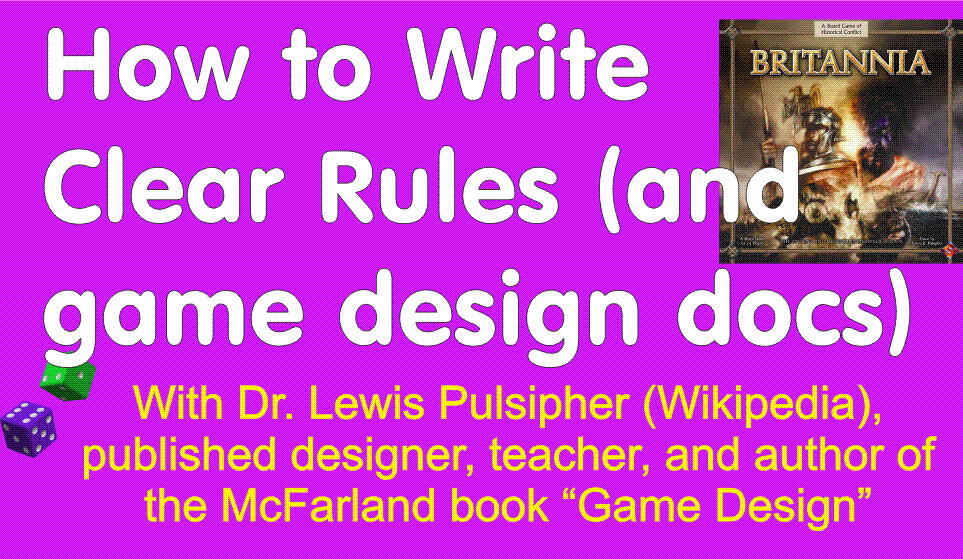The surprisingly large attendance at my talk about “How to Write Clear Rules” at GenCon made me focus on the fact that there is nothing in print about writing game rules, other than the occasional blog post, and a chapter in the “Kobold Guide to Boardgame Design” by Mike Selinker that is primarily an exhortation to use simple, clear language in your rules. (Mike also recapitulated that chapter in a well-attended talk at GenCon.)
I have less than 20 participants so far in my online audiovisual class “How to Write Clear Rules (and game design documents)” on Udemy.com and Courses.Pulsiphergames.com. Like everything else in the digital age the course suffers from anonymity, more commonly called in games “discoverability” - if people don’t know it exists they can’t “consume” it. Of course it also suffers from being very specific, appealing primarily to aspiring tabletop game designers.
I’ve heard of other instructors at Udemy turning their courses into short electronic books. Because I’ve recorded more than 50 fairly short “lectures” for this class I actually have a large body of words that I could turn into a short book. I can run each screencast through CyberLink PowerDirector a second time and save it as a WAV file that can then be transcribed by the Dragon NaturallySpeaking Premium software that I write with.
The voice recognition is definitely not perfect, a time-consuming obstacle to the project. Perhaps a greater one is that I speak my screencasts on-the-fly, that is I don’t work from a full script but only from notes that are the slides in the screen cast. Consequently I speak in a fairly casual rather than formal manner, the same manner I would use in my 17,000 hours of experience in the classroom where I tried to talk with the students rather than at them (small classes thank heaven). That style, when transformed to the written word, is wordy and informal. Consequently a great deal of editing is required to turn a transcription into satisfactory writing, both because of Dragon’s errors and because of the difference in style and delivery.
Nonetheless I have begun to do this, and of course all writers and game designers know that it’s easy to start a project but difficult to finish it. At this point I don’t really know how long it’s going to be - it will include some long rulesets of published games as examples - but I estimate somewhere around 50,000 words. The typical novel is 100,000 words and 50,000 is generally regarded as the minimum size, so this will be shorter than a normal book. (My McFarland book “Game Design” is just over 100,000 words, intentionally - I didn’t want to write a massive book that might put people off.) So this will be a thin paper book if it’s ever available in paper. My primary goal is to sell it as an e-book whether through Amazon or through a place like RPG now I don’t yet know.
The course:
$4 off "How to Write Clear Rules (and game design documents)" ($23)
https://www.udemy.com/how-to-write-clear-rules/?couponCode=WCR4%24offnew
You can see some sample screencasts without registering, and there's a 30 day money back guarantee.
Wednesday, August 27, 2014
Subscribe to:
Post Comments (Atom)
"Always do right--this will gratify some and astonish the rest."Mark Twain
"A designer knows he has achieved perfection not when there is nothing left to add, but when there is nothing left to take away." Antoine de Saint-Exup'ery
"Not everything that can be counted counts, and not everything that counts can be counted." Albert Einstein
"Make everything as simple as possible, but not simpler." Albert Einstein





3 comments:
Hi there! Do yyou use Twitter? I'd like to follow you iff that would bbe okay.
I'm definitely enjoying your blog and look forward to new updates.
Also visit my blog post; Wordpress Lessons
@lewpuls
Not an avid user, I post average once a day, most often references to interesting articles.
Lewis!! it was an interesting post about audiovisual information.
Post a Comment